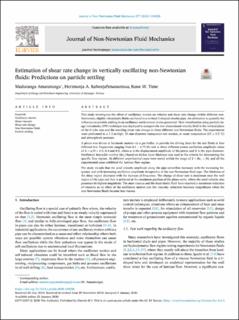| dc.contributor.author | Amaratunga, Polwattage Don Malitha Maduran | |
| dc.contributor.author | Rabenjafimanantsoa, Herimonja Andrianifaliana | |
| dc.contributor.author | Time, Rune | |
| dc.date.accessioned | 2023-02-09T07:47:39Z | |
| dc.date.available | 2023-02-09T07:47:39Z | |
| dc.date.created | 2020-10-07T13:57:14Z | |
| dc.date.issued | 2020 | |
| dc.identifier.citation | Amaratunga, M., Rabenjafimanantsoa, H. A., & Time, R. W. (2020). Estimation of shear rate change in vertically oscillating non-Newtonian fluids: Predictions on particle settling. Journal of Non-Newtonian Fluid Mechanics, 277, 104236. | en_US |
| dc.identifier.issn | 0377-0257 | |
| dc.identifier.uri | https://hdl.handle.net/11250/3049481 | |
| dc.description.abstract | This study investigates the effect of oscillatory motion on velocity and shear rate change within different non-Newtonian, slightly viscoelastic fluids oscillated in a vertical U-shaped circular pipe. An estimation to quantify the influence on particle settling in an oscillatory environment is also presented. Flow visualization using particle image velocimetry (PIV) technique was deployed to compare the two-dimensional velocity field in the vertical plane of the U-tube axis and the resulting shear rate change in three different non-Newtonian fluids. The experiments were performed in a 1.2 m high, 50 mm diameter transparent test section, at room temperature (21 ± 0.5 °C) and atmospheric pressure.
A piston was driven at harmonic motion via a gas buffer, to provide the driving force for the test fluids at four different low frequencies ranging from 0.1 – 0.75 Hz and at three different piston oscillation amplitude ratios of A = a/D = 0.3, 0.4 and 0.5, where a is the displacement amplitude of the piston and D is the pipe diameter. Oscillatory Reynolds number (Reδ) based on Stokes layer thickness was used as the criteria for determining the specific flow regime. 36 different experimental cases were tested within the range of 2 < Reδ < 34, and all the experimental cases exhibited the laminar flow regime.
The study reveals that the axial velocity amplitude along the pipe centerline increases with the increasing frequency and with increasing oscillation amplitude irrespective of the non-Newtonian fluid type. The thickness of the shear region decreases with the increase of frequency. The change of shear rate is maximum near the wall region of the pipe and that is achieved at the maximum position of the phase cycle, where the axial velocity also possesses its highest magnitude. The most viscous and the least elastic fluid have reported a maximum reduction of viscosity as an effect of the oscillatory motion and the viscosity reduction becomes insignificant when the non-Newtonian fluids become less viscous. | en_US |
| dc.language.iso | eng | en_US |
| dc.publisher | Elsevier | en_US |
| dc.rights | Navngivelse 4.0 Internasjonal | * |
| dc.rights.uri | http://creativecommons.org/licenses/by/4.0/deed.no | * |
| dc.title | Estimation of shear rate change in vertically oscillating non-Newtonian fluids: Predictions on particle settling | en_US |
| dc.type | Peer reviewed | en_US |
| dc.type | Journal article | en_US |
| dc.description.version | publishedVersion | en_US |
| dc.rights.holder | The authors | en_US |
| dc.subject.nsi | VDP::Teknologi: 500 | en_US |
| dc.source.pagenumber | 0 | en_US |
| dc.source.volume | 277 | en_US |
| dc.source.journal | Journal of Non-Newtonian Fluid Mechanics | en_US |
| dc.identifier.doi | 10.1016/j.jnnfm.2020.104236 | |
| dc.identifier.cristin | 1837949 | |
| cristin.ispublished | true | |
| cristin.fulltext | original | |
| cristin.qualitycode | 1 | |

